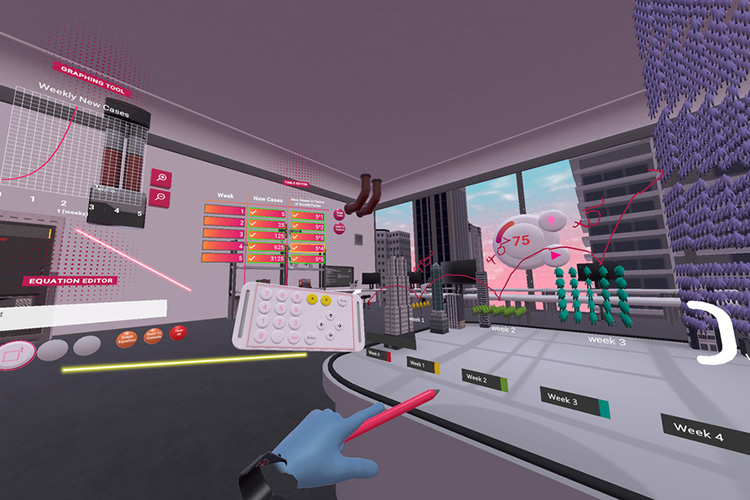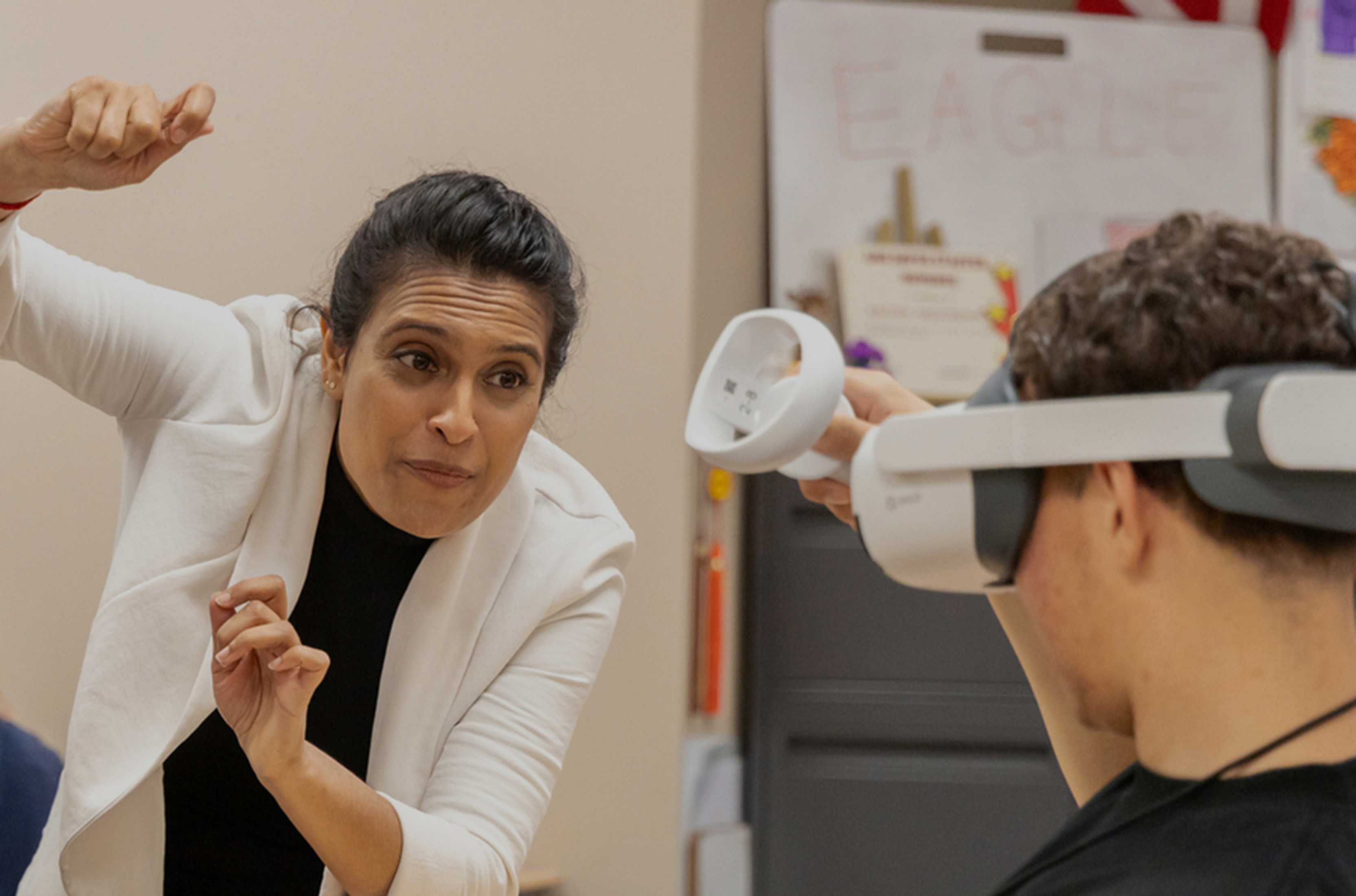Using Spatial Learning to Transform Math and Science Education
-
-
MIT News
Filed Under
Legend has it that Isaac Newton was sitting under a tree when an apple fell on his head, sparking a bout of scientific thinking that led to the theory of gravity. It’s one of the most famous stories in science, perhaps because it shows the power of simple human experiences to revolutionize our understanding of the world around us.
About five years ago, Anurupa Ganguly ’07, MEng ’09 noticed kids don’t learn that way in schools.
“Students should learn how to use language, notation, and eventually shorthand representation of thoughts from deeply human experiences,” Ganguly says.
That’s the idea behind PrismsVR. The company offers virtual reality experiences for students, using physical learning to teach core concepts in math and science.
The platform can radically change the dynamics of the classroom, encouraging self-paced, student-led learning, where the teacher is focused on asking the right questions and sparking curiosity.
Instead of learning biology with a pen and paper, students become biomedical researchers designing a tissue regeneration therapy. Instead of learning trigonometry in a textbook, students become rural architects designing a new school building.
“We’re building a whole new learning platform, methodology, and tech infrastructure that allows students to experience problems in the first person, not through abstractions or 2D screens, and then go from that experience to ascribe meaning, language, and build up to equations, procedures, and other nomenclature,” Ganguly explains.
Today PrismsVR has been used by about 300,000 students across 35 states. The company’s approach was shown to boost algebra test scores by 11 percent in one study, with larger, multistate studies currently underway through funding from the Gates Foundation.
“Education has been in desperate need of real reform for many years,” Ganguly says. “But what’s happened is we’ve just been digitizing old, antiquated teaching methods instead. We would take a lecture and make it a video, or take a worksheet and make it a web app. I think districts see us taking a more aspirational approach, with multimodal interaction and concepts at the center of learning design, and are collaborating with us to scale that instead. We want to get this to every single public school student across the US, and then we’re going into community colleges, higher ed, and international.”
A New Paradigm for Learning
Ganguly was an undergraduate and master’s student in MIT’s Department of Electrical Engineering and Computer Science. When she began as an undergrad in 2003, she estimates that women made up about 30 percent of her class in the department, but as she advanced in her studies, that number seemed to dwindle.
“It was a disappearing act for some students, and I became inspired to understand what’s happening at the K-12 levels that set some students up for success and led to fragile foundations for others,” Ganguly recalls.
As she neared the end of her graduate program in 2009, Ganguly planned to move to California to take an engineering job. But as she was walking through MIT’s Infinite Corridor one day, a sign caught her eye. It was for Teach for America, which had collaborated with MIT to recruit students into the field of teaching, particularly for high need and high poverty students.
“I was inspired by that idea that I could use my education, engineering background, and disciplined systems thinking to think through systemic change in the public sector,” says Ganguly, who became a high school physics and algebra teacher in the Boston Public Schools.
Ganguly soon left the classroom and became director of math for the district, where she oversaw curriculum and teacher upskilling. From there, Ganguly went to New York City Public Schools, where she also supported curriculum development, trying to relate abstract math concepts to students’ experiences in the real world.
“As I began to travel from school to school, working with millions of kids, I became convinced that we don’t have the tools to solve the problem I thought about at MIT — of truly leveling the playing field and building enduring identities in the mathematical sciences,” Ganguly says.
The problem as Ganguly sees it is that students’ world is 3D, complex, and multimodal. Yet most lessons are confined to paper or tablets. For other things in life, students learn through their complex experiences: through their senses, movement, and emotions. Why should math and science be any different? In 2018, the Oculus Quest VR headset was released, and Ganguly thought she had found a more effective learning medium to scale how we learn.

But starting an education company based on virtual reality at the time was audacious. The 128-gigabyte Quest was priced at $500, and there were no standards-based VR curricula or standalone VR headsets in U.S. K-12 schools.
“Investors weren’t going to touch this,” Ganguly jokes.
Luckily, Ganguly received a small amount of funding from the National Science Foundation to build her first prototype. Ganguly started with Algebra 1; performance in this class is one of the top predictors of lifetime wages but has shown a stubbornly persistent achievement gap.
Her first module, which she built during the pandemic, places students in a food hall when a sudden announcement from the mayor rings out. There’s an alarming growth of an unknown virus in the area. The students get the power to travel back in time to see how the virus is spreading, from one person’s sneeze to many people’s behaviors in a demonstration of multiplicative growth.
The people turn to dots in a simulation as the journey moves to interactive, tactile data visualization, and the students are charged with figuring out how many weeks until the hospitals run out of capacity. Once the learning design for VR was established, Ganguly continued to build experiences across the curriculum in geometry, algebra II and III, biology, chemistry, and middle school subjects. Today Prisms covers all math and science subjects in grades seven to eleven, and the company is currently building out calculus, data science, and statistics for upper and postsecondary school. By the fall of 2025, Prisms will have evergreen content up to grade level 14.
Following the experiences, students gather in small groups to reflect on the lessons and write summaries. As students go through their virtual experiences, teachers have a web dashboard to monitor each child’s progress to support and intervene where needed.
“With our solution, the role of the teacher is to be Socrates and to ask high-quality questions, not deliver knowledge” Ganguly says.
As a solo founder, Ganguly says support from MIT’s Venture Mentoring Service, which offers members of the MIT community startup guidance in the form of “board meetings” led by successful entrepreneurs, was crucial.
“The MIT founder community is different,” Ganguly says. “We’re often technical founders, building for ourselves, and we build our company’s first product. Moving from product to your go-to-market strategy and hiring is a unique journey for product-minded founders.”
From Textbooks to Experiences
A few years ago, Ganguly’s team was leading a classroom coaching session in a Virginia school district when a teacher told her about a student named Silas.
“The teacher was saying, ‘Silas never does anything, he just sits in the back of class,’” Ganguly recalls. “I’ve seen this like clockwork, so we just said, ‘Let’s give Silas a fresh shot and see what we can do.’ Lo and behold, Silas was the first one to finish the module and write a full synthesis report. The teacher told me that was the first time Silas has turned in an assignment with everything filled in.”
Ganguly says it’s one of thousands of anecdotes she has.
“A lot of students feel shut out of the modern math classroom because of our stubborn approach of drill and kill,” Ganguly says. “Students want to learn through great stories. They want to help people. They want to be empathetic. They want their math education to matter.”
Ganguly sees PrismsVR as a fundamentally new way for students to learn no matter where they are.
“We intend to become the next textbook,” Ganguly says. “The next textbooks will be spatial and experiential.”
This story was originally published by MIT News.
Images courtesy of PrismsVR









